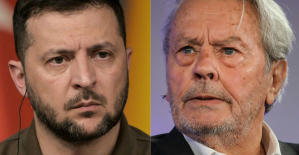The princes of Rus could have known. As early as May 1223, a Mongolian army had cut a path of devastation through the steppe and destroyed a Russian army on the Kalka River (today Kalmius) in eastern Ukraine. The winners celebrated their triumph with a feast under which the losers were miserably crushed. But then the wild riders suddenly left.
That was to change 14 years later. Another Mongolian army appeared in Russia, but this time it had a different mission. In 1223 it was basically about enlightenment, since the founder of the empire, Genghis Khan, who was still alive at the time, wanted to know which neighbors lived in the far west. In 1234 a council of war in distant Karakorum had decided to incorporate the then explored country into the world empire. The order for this was given by the new Great Khan Ögedei to his nephew Batu (1205-1255). His conquests earned him the nickname "the Magnificent".
Batu was the second eldest son of Genghis Khan's eldest son Jochi. Actually, the eldest Orda should have assumed his inheritance. But the fact that he renounced in favor of his brother could be evidence of the insight that Batu possessed greater qualities as a ruler. This also upset the delicate balance among Genghis Khan's heirs. Because Dschötschi had once refused his father's allegiance during a campaign, which is said to have angered him very much. Instead, Jochi liked to reside in the "Khanate of the Westerners" in Siberia, which he developed into his own center of power.
It is therefore quite possible that the decision to entrust Batu with the great western offensive was also motivated by the desire to remove him from the center of the Mongol empire in this way. Systematically Batu prepared his campaign. Up to 140,000 soldiers were assembled, plus servants, slaves, women, children, perhaps more than half a million people, as well as millions of horses, sheep, goats. Basically, it was a whole people that relentlessly rolled westward across the Eurasian steppes.
The first victims were the Volga Bulgarians in 1236. The Kipchaks, also known as Cumans, followed. At the end of 1238, the attack on the Kiev Empire began. It was founded as a tribute empire by Swedish Vikings, the Varangians, in the 9th century. In the meantime, however, the northerners had merged with their Slavic and Finnish subjects and had accepted Christianity under Vladimir I in 988. Their princes jealously guarded their position, which had already led to the catastrophe on the Kalka.
Now the Mongols set about besieging the Russian cities one by one. Those who voluntarily submitted had a chance of being left alive. Those who resisted were wiped out, especially the elite. However, craftsmen and other specialists were spared and often deported to the Reich. A total of 49 of 72 cities of the "Orusut", as the "Secret History" of the Mongols calls the Russians, are said to have been more or less destroyed.
The spring mud of 1239 probably saved the rich trading city of Novgorod, the wealthy center of Rus' in the north. After ordering a rest for his army, Batu began the siege of Kyiv in November 1240. Since it was only a few days' march from the steppe border, the Varangians had made the city on the Dnieper the center of their empire. Now the situation led to its downfall.
Presumably, Batu's army was so large that it was able to encircle the whole of Kyiv. Catapults and drilling rams brought down the walls. The residents finally took refuge in the church of the tithe, but the galleries collapsed under the load and many people were buried under them. On December 6, Kyiv surrendered.
The image has left a deep mark on Russian commemorative culture: "The pagan warriors slaughtered everyone down to the last monk-priest and burned the whole city," summed up a modern Russian historian. The papal envoy Plano Carpini, who visited the ruins in 1246, found only 200 busy courtyards. Of the 36,000 to 50,000 inhabitants, only 2,000 are said to have escaped with their lives.
Batu didn't stop there: he moved further west and conquered Galicia. There he divided his army. One wing marched to Silesia, where in April 1241 Duke Heinrich II lost his life and battle near Liegnitz (Legnica). The other wing devastated Hungary.
Contemporaries attributed the fact that Batu left unexpectedly to the intervention of God. The reason was probably more prosaic. Great Khan Ogedei had died in Karakorum, and Batu wanted to be involved in choosing a successor. Since Batu supported his nephew, the victor Möngke, he was able to expand his power base in the west. From it emerged the Khanate of the Golden Horde, which soon developed a life of its own.
Another reason for Batu to spare western Europe may have been his army organization. The huge herds wanted to be fed, which was hardly possible beyond the steppe. The Golden Horde also established its center in the steppe zone and was content with paying tribute and punitive expeditions.
However, the Russian image of being overrun by uncivilized savages is far from reality. Batu relied on careful reconnaissance, had modern siege technology and relied on an efficient intelligence service. His soldiers maintained strict discipline and, in the composite bow, had an excellent long-range weapon at their disposal. With this set of instruments, the Golden Horde and its partial khanates were able to secure rule over Russia for 250 years.
You can also find "World History" on Facebook. We are happy about a like.

 Sydney: Assyrian bishop stabbed, conservative TikToker outspoken on Islam
Sydney: Assyrian bishop stabbed, conservative TikToker outspoken on Islam Torrential rains in Dubai: “The event is so intense that we cannot find analogues in our databases”
Torrential rains in Dubai: “The event is so intense that we cannot find analogues in our databases” Rishi Sunak wants a tobacco-free UK
Rishi Sunak wants a tobacco-free UK In Africa, the number of millionaires will boom over the next ten years
In Africa, the number of millionaires will boom over the next ten years WHO concerned about spread of H5N1 avian flu to new species, including humans
WHO concerned about spread of H5N1 avian flu to new species, including humans New generation mosquito nets prove much more effective against malaria
New generation mosquito nets prove much more effective against malaria Covid-19: everything you need to know about the new vaccination campaign which is starting
Covid-19: everything you need to know about the new vaccination campaign which is starting The best laptops of the moment boast artificial intelligence
The best laptops of the moment boast artificial intelligence Bitcoin halving: what will the planned reduction in emissions from the queen of cryptos change?
Bitcoin halving: what will the planned reduction in emissions from the queen of cryptos change? The Flink home shopping delivery platform will be liquidated in France
The Flink home shopping delivery platform will be liquidated in France Bercy threatens to veto the sale of Biogaran (Servier) to an Indian industrialist
Bercy threatens to veto the sale of Biogaran (Servier) to an Indian industrialist Switch or signaling breakdown, operating incident or catenaries... Do you speak the language of RATP and SNCF?
Switch or signaling breakdown, operating incident or catenaries... Do you speak the language of RATP and SNCF? The main facade of the old Copenhagen Stock Exchange collapsed, two days after the fire started
The main facade of the old Copenhagen Stock Exchange collapsed, two days after the fire started Alain Delon decorated by Ukraine for his support in the conflict against Russia
Alain Delon decorated by Ukraine for his support in the conflict against Russia Who’s Who launches the first edition of its literary prize
Who’s Who launches the first edition of its literary prize Sylvain Amic appointed to the Musée d’Orsay to replace Christophe Leribault
Sylvain Amic appointed to the Musée d’Orsay to replace Christophe Leribault Skoda Kodiaq 2024: a 'beast' plug-in hybrid SUV
Skoda Kodiaq 2024: a 'beast' plug-in hybrid SUV Tesla launches a new Model Y with 600 km of autonomy at a "more accessible price"
Tesla launches a new Model Y with 600 km of autonomy at a "more accessible price" The 10 best-selling cars in March 2024 in Spain: sales fall due to Easter
The 10 best-selling cars in March 2024 in Spain: sales fall due to Easter A private jet company buys more than 100 flying cars
A private jet company buys more than 100 flying cars This is how housing prices have changed in Spain in the last decade
This is how housing prices have changed in Spain in the last decade The home mortgage firm drops 10% in January and interest soars to 3.46%
The home mortgage firm drops 10% in January and interest soars to 3.46% The jewel of the Rocío de Nagüeles urbanization: a dream villa in Marbella
The jewel of the Rocío de Nagüeles urbanization: a dream villa in Marbella Rental prices grow by 7.3% in February: where does it go up and where does it go down?
Rental prices grow by 7.3% in February: where does it go up and where does it go down? With the promise of a “real burst of authority”, Gabriel Attal provokes the ire of the opposition
With the promise of a “real burst of authority”, Gabriel Attal provokes the ire of the opposition Europeans: the schedule of debates to follow between now and June 9
Europeans: the schedule of debates to follow between now and June 9 Europeans: “In France, there is a left and there is a right,” assures Bellamy
Europeans: “In France, there is a left and there is a right,” assures Bellamy During the night of the economy, the right points out the budgetary flaws of the macronie
During the night of the economy, the right points out the budgetary flaws of the macronie These French cities that will boycott the World Cup in Qatar
These French cities that will boycott the World Cup in Qatar Europa Conference League: the semi-final flies to Lille, which loses to the wire against Aston Villa
Europa Conference League: the semi-final flies to Lille, which loses to the wire against Aston Villa Lille-Aston Villa: Cash disgusts Lille, the arbitration too... The tops and the flops
Lille-Aston Villa: Cash disgusts Lille, the arbitration too... The tops and the flops Handball: Les Bleues in the same group as Spain at Euro 2024
Handball: Les Bleues in the same group as Spain at Euro 2024 Europa Conference League: for Létang, Martinez “does not have the attitude of a high-level athlete”
Europa Conference League: for Létang, Martinez “does not have the attitude of a high-level athlete”


















